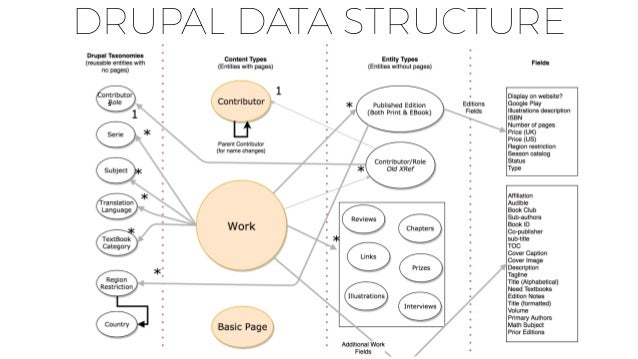Background
TL;DR Future upgrades will be backwards compatible to all Drupal version 8 functionality and libraries. Upgrades will cost less in development times. Islandora’s objects are now more like Drupal nodes, which means that the Drupal community now can participate in the active development of Islandora. This expands the community to include Drupal and their massive community of professionals. Content is compatible with 3rd party addons.
Islandora 7 is a monolithic application that glues Drupal 6/7 to Fedora 3 with an optional institutional repository (IR) addon. Islandora 7 had several pain points, such as workflows, most of which required substantial coding to work around these issues. Although Islandora is a collection of several Drupal 6/7 modules, it wasn’t written in a way that leveraged much of Drupal’s content management functionality. Fortunately the release of Drupal 8 has remedied this.
Future upgrades of Drupal versions will look substantially different than before. Gone are the days of major migration planning as Drupal has completely overhauled their application lifecycle. Drupal 9 was released in June 2020 the process of upgrading won’t cause any loss in functionality or any libraries to break; the core is completely backwards compatible. This important feature was adopted for the new life cycle for all future version releases. It was explained simply by Alex Lopez, “You’ll just get notices advising you to upgrade libraries, function calls, and anything else in your code that would make your module incompatible with a Drupal 10 version. But, theoretically, nothing that would break your module/site.”(2018). A large focus of Drupal core and module development for the 8 release was on specific industries, including but not limited to big data and higher education. “Build a wide range of solutions from university websites, applications, scholarly publishing, and more.” (Drupal for education, 2020).

The Drupal 8 release in 2015 had a major overhaul of the code base. This meant that upgrading from Drupal 7 into Drupal 8 broke content libraries, functions, and theming. Drupal 8’s migration is an Extract, Transform, Load (ETL) process as part of its Migrate API. The data can come from a variety of places; a database, CSV, JSON, or REST function, and then transformed, imported, and processed (Migrate API overview, 2019).
Islandora changed the development approach to align with Drupal 8’s direction. A major focus on Islandora 8 is to build the stack in a way that fully utilizes Drupal 8 and make the contributed modules available. There are so many modules currently developed and actively managed by other institutions that provide content modeling that developing metadata has become exceedingly easier. As the need for IRs increases, the number of options available have increased as well making it sometimes difficult to sift through to find the best option for the community. Since these modules are only a couple of years old, many of these lack sufficient documentation or guidance on how to best utilize the modules for a digital or institutional repository. The Islandora community makes every effort to bring content models together by research, community vetting, writing documentation, and creating solutions to help provide a ready made (turnkey) solution.
The benefits of using Islandora 8 (i.e. Drupal 8, Solr, and a self-described “bento box” of other technology) include continuing to leverage the Drupal expertise we have in it. Using Drupal 8 for UT Collections would beneficially build on that existing knowledge and infrastructure. Islandora 8 is more closely tied to Drupal 8 than Islandora 7 was to Drupal 7, especially in terms of managing collections and object storage. For example, metadata is no longer just an XML file in Fedora that gets indexed in Solr. With Islandora 8, metadata is actually stored and managed as fields in the Drupal database. The Introduction to Islandora 8 webinar notes that “metadata profiles are created via Drupal content types” and “it can be serialized into other formats (XML, JSON, JSON-LD) on demand”. Batch metadata updates are made possible through Drupal’s Views Bulk Operations by a “Modify Field Values” operation. Metadata display is configurable in the Drupal View associated with the object type. Islandora 8 promises to make good use of Drupal this time around.

Islandora 8 community developers are also proposing interesting ways of integrating IIIF, such as generating IIIF manifests from Drupal Views results. The downside of continuing to use Drupal for Collections is there is a steep learning curve for collection owners in Islandora 8, since the level of configuration possibilities has increased dramatically compared to 7. Continuing down the Drupal path means that the Collections service must continue to offer collection owners with sufficient Drupal 8 training and support. The question that hangs on Drupal 8 is: will it complicate or simplify collection building for our development team and how long would it take to migrate?
Islandora 8 content is now utilizing Drupal nodes as the primary representation instead of how Islandora 7 overwrote Drupal routing to provide an object and it’s content. Islandora 8 content is Drupal content (stored in Fedora 5) and is completely compatible with 3rd party addons. In almost every case the Islandora content is treated exactly the same as any other content imported into a base Drupal.
How do you become a partner
Partners pay $10,000 CAD each year for partner membership. Members pay either $2,000 or $4,000 each year for a standard membership.
How many partners are there
As of July 2020 there are 12 partners and 24 members.
Partners
- UPEI
- discoverygarden
- LYRASIS
- McMaster University
- Born-Digital
- University of Manitoba
- Florida State University
- Simon Fraser University
- University of Tennessee Knoxville
- Marmot Library Network
- University of Toronto
- Islandora Collaboration Group
Members
- Agile Humanities
- American Philosophical Society
- Amherst College
- Berklee College of Music
- British Columbia Electronic Library Network
- California Institute of Technology
- Chinese University of Hong Kong
- Delft University
- Digital Echidna
- Florida Virtual Campus
- Johns Hopkins
- Lib4RI
- Leiden University
- Louisiana State University
- Metropolitan New York Library Council (METRO)
- Ontario Colleges Library Service
- PALS
- Smithsonian Institute
- University of Connecticut
- University of Nevada, Las Vegas
- University of Saskatchewan
- University of Texas at Austin
- Tulane University
- York University
Are there fees involved
(not related to memberships) “Just a smile.” - Melissa Anez (Islandora’s Project & Community Manager).
How is governance and decision making handled?
By-laws: https://islandora.ca/if/governance Governing group breakdown: https://islandora.ca/if/committees The Role of Interest Groups(IGs): https://islandora.ca/collaborate
Extra
Technical video walkthrough on Princeton’s content migration into Drupal 8.
Notes
Where Do We Go From Here: A Review of Technology Solutions for Providing Access to Digital Collections: https://journal.code4lib.org/articles/15000

